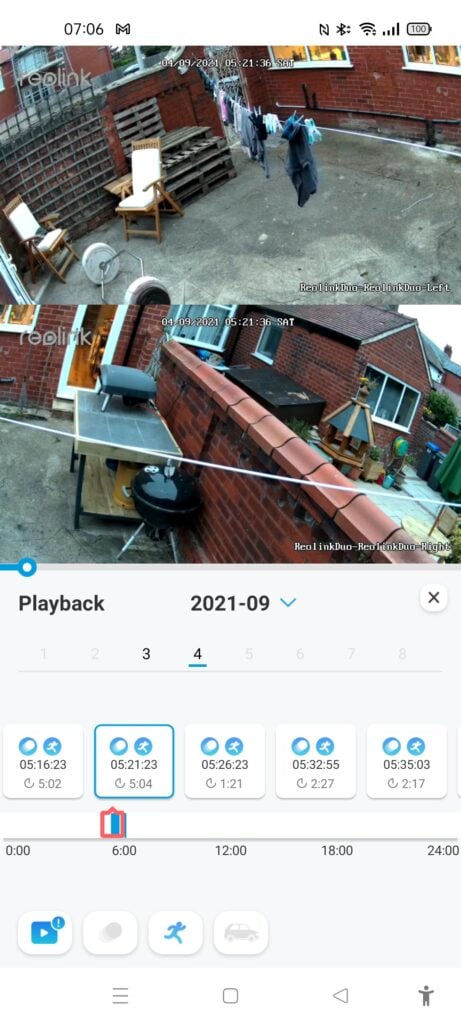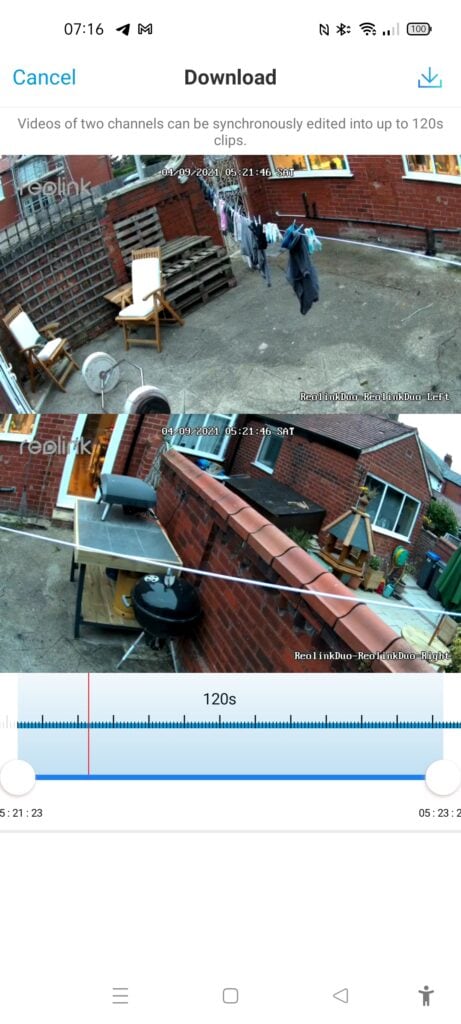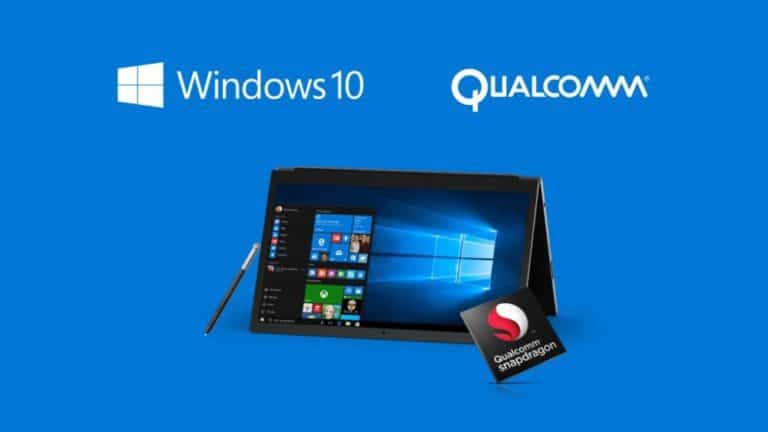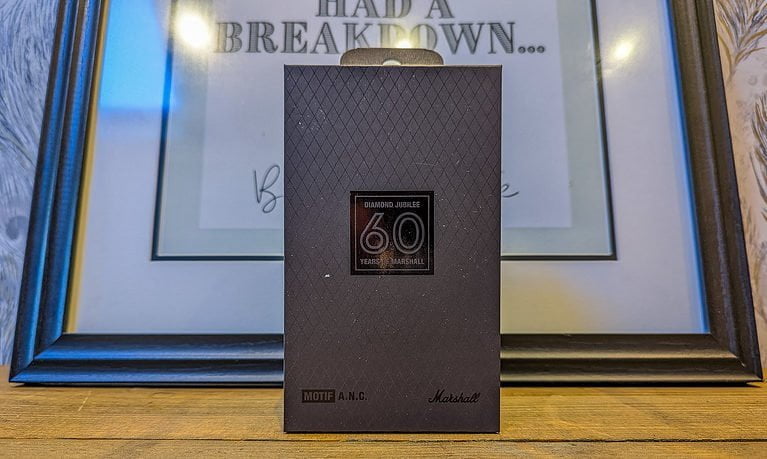Any links to online stores should be assumed to be affiliates. The company or PR agency provides all or most review samples. They have no control over my content, and I provide my honest opinion.
Page 1 covered the specification, set up, image stitching and some thoughts on the performance
Reolink Duo Sample Footage Day Time
Reolink Duo Sample Footage at Night
The two video lengths don’t match up so it looks like I pulled mismatched videos from the NVR. I reupload the correct videos at some point.
The right camera triggers the spotlight switches on just after 1m35 when a car passes by. It also switches on at 7m48 as two people cross the street.
Motion Detection
The motion detection works the same as it has for the majority of recent Reolink reviews. It can intelligently distinguish between cars and people rather than just moving bushes. As mentioned before, this also triggers the spotlight for colour night recording.
It works quite well, much better than old fashioned motion detection, but not quite as advanced as things like Sentry AI on Blue Iris or the face detection with Netatmo.
With the app and the motion detection, when you have both feeds loaded and select an event, it loads the correct time for both feeds at the same time. When you click on download it will download the correct two records. Whereas, with my exported NVR recordings above I manually selected the times for each feed separately.
Reolink Duo Price, Availability and Alternative Options
Reolink has now confirmed that the MSRP of 4 versions will be around $110(PoE), $130(WiFi), $200(battery WiFi) and $300(battery 4G). This is actually more attractively priced than I had imagined with it likely being cheaper to buy this than run two separate cameras.
The inclusion of a WiFi, Battery and 4G options also differentiate this range from anything else on the market. The WiFi battery and battery 4G models are particularly interesting allowing you to cover a wide area remotely using one camera. It will be interesting to see how the battery copes, though.
To the best of my knowledge, there is nothing on the market at the consumer level that is comparable to this.
The cheapest alternative solution would be a fisheye lens, but the fisheye field of view loses a lot of detail, most of the affordable options have terrible reviews. Alternatively, an auto-tracking PTZ camera may offer a similar end result.
Hikvision and Wisenet have some multi-directional panoramic cameras which cost well over £1000. I am assuming this is where Reolink took their inspiration from. The £1.4K Hikvision DS-2CD6924G0-HIS offers multiple streams, including a panoramic stream up to 6480 × 1080, giving a 180° field of view via four separate cameras.
Overall
I was impressed with the Reolink Duo before I knew the prices and different options. With a price of around $110 the Reolink Duo should work out considerably cheaper than running two similarly specced cameras side by side, while also being considerably cheaper.
Even ignoring the price the convenience of these cameras is excellent. It is without a doubt much more convenient to install one camera with one POE connection vs two. This is especially true if you have gone to the hassle of running cables outdoors then realising you want to cover a wider area than what a single camera can provide.
If money is less of an issue you could still just run two Reolink cameras side by side can give you effectively the same functionality but with a higher resolution. The Reolink RLC-811A is 4K with 5x zoom and a spotlight for around £90, it is quite large, though, so two of them side by side may look a bit over the top. Alternatively, there is the Reolink RLC-812A which isn’t out yet but has an always-on (at night) spotlight. Now that I know the MSRP of the Duo, running two side by side cameras looks even less appealing.
Overall, though, this is a great camera that many people will find very useful, and it is good to see Reolink trying out different technologies to see what works. It is also good enough that I have swapped out one of my older Reolink cameras in my back garden and replaced it with this as a permanent solution, allowing me to cover the entirety of my yard.
Reolink Duo Review Rating
Summary
The Reolink Duo is an excellent and relatively innovative solution to implementing surveillance across a wide viewing angle without the need for multiple cameras. The dual-lens multi-directional system is then complimented by spotlights and AI object detection.
I adjusted the score of this now I know the price. 95% may be a little over-generous but there is nothing on the market that is directly competing with it and I think it is priced very attractively.
Overall
95%-
Overall - 95%95%
Pros
- One physical camera that covers 150 degrees field of view
- A unique solution at the consumer price point level
- Considerably simplifies installation if you already have wires in place but want a wider angle/second camera
- Priced attractively – cheaper than running two separate cameras
Cons
- No panoramic stream
- Not a huge benefit vs running two cameras side by side (apart from price)
I am James, a UK-based tech enthusiast and the Editor and Owner of Mighty Gadget, which I’ve proudly run since 2007. Passionate about all things technology, my expertise spans from computers and networking to mobile, wearables, and smart home devices.
As a fitness fanatic who loves running and cycling, I also have a keen interest in fitness-related technology, and I take every opportunity to cover this niche on my blog. My diverse interests allow me to bring a unique perspective to tech blogging, merging lifestyle, fitness, and the latest tech trends.
In my academic pursuits, I earned a BSc in Information Systems Design from UCLAN, before advancing my learning with a Master’s Degree in Computing. This advanced study also included Cisco CCNA accreditation, further demonstrating my commitment to understanding and staying ahead of the technology curve.
I’m proud to share that Vuelio has consistently ranked Mighty Gadget as one of the top technology blogs in the UK. With my dedication to technology and drive to share my insights, I aim to continue providing my readers with engaging and informative content.











The new Reolink dou how much in Australian dollars ..cheers
Sorry, I don’t know, they have only published a guide price and in US dollars – I don’t even know the UK pricing.
I was having issues with the connection going in and out with this method. After playing around with it a bit I found out you can also use the Reolink settings and it fixed my issue:
Make: ReoLink
Model: *RLC-410/411/420………
Stream Profile Main:
Left Camera
/bcs/channel0_main.bcs?channel=0&stream=0&user={id}&password={pw}
Right Camera
/bcs/channel1_main.bcs?channel=1&stream=0&user={id}&password={pw}
Thank you, this page was very helpful for my installation.
I have just a problem with the lights. When Blueiris trigger a movement it records, but it does not torn on the flash lights.
How i have to configure this in Blueiris?
Thank you